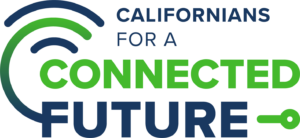

Frequently Asked Questions About AB 470
What You Need to Know
What is Californians for a Connected Future?
Californians for a Connected Future (CCF) is a broad, growing and bipartisan coalition of more than 150 social justice advocates, public safety and elected officials, Tribal and community leaders, veterans, non-profits, ethnic businesses, education, youth services and disability rights champions supporting Assembly Bill 470. The bill will modernize state law to accelerate investments in modern, reliable, and affordable communications for all.
AB 470 is a responsible plan to build more broadband across California to provide faster, safer, and more reliable connectivity to those who need it the most.
What is Californians for a Connected Future advocating for?
Our coalition believes all Californians deserve reliable, fast, and affordable communications options. But outdated state laws result in massive investments in aging copper landline technology that consumers are increasingly abandoning because it does not meet their needs. It’s time to build for our future, strengthen our workforce, and foster innovation.
Our coalition is supporting AB 470 because it will encourage investments in advanced communications options, bringing more broadband to more Californians while ensuring no Californian or community is left behind. Developed through extensive input from policymakers and stakeholders, AB 470 will move California forward while protecting consumers, preserving access to essential voice services, strengthening public safety, and preparing the state for the future.
What does AB 470 do?
Current regulations prioritize legacy infrastructure maintenance, hindering investments in more modern communication options that our state should focus on, particularly for rural and underserved communities. AB 470 promotes a responsible, accelerated shift to modern communications options while simultaneously protecting Californians with copper landline service. For those areas deemed not “well-served,” legacy services will continue to be maintained.
By reforming the state’s Carrier of Last Resort Policy (COLR), AB 470 will ensure critical investments are made to support the consumer needs of today, strengthen public safety, and preserve access to affordable voice services while ensuring that no Californian or community is left behind.
How many Californians still have a copper landline?
Only 5% of households within the service area of the state’s largest landline provider still subscribe to copper-based home phone service – a number that continues to decline. Consumers are overwhelmingly choosing to use wireless or internet-based communications services because they are more reliable and versatile.
AB 470 will accelerate investments in newer, more reliable technologies – instead of maintaining an outdated copper network. The bill ensures this transition is conducted gradually, over time, and that no community is left without reliable and affordable home phone service.
If AB 470 passes, will customers lose access to copper landlines immediately?
Absolutely not. Current copper legacy services will be maintained until new technologies are available and are proven to be equally or more reliable and affordable, preserving access to critical voice services. In populated areas not identified as “well-served,” nothing changes, and current law remains in effect.
Before any changes occur, AB 470 requires the CPUC to designate geographic areas. Modernization will only be permitted in areas that are unpopulated and without customers, or designated as “well-served,” meaning:
-
At least three alternative voice services are available:
-
At least one alternative must be a wireline provider,
-
At least two basic voice service options, priced comparably to COLR copper landline rates,
-
At least one alternative must participate in the discounted California LifeLine program.
-
-
For amended status areas, what if all alternative providers leave and stop providing voice services?
In the unlikely event all providers exit a “well-served” area, leaving no alternatives, AB 470 includes a safety net that requires the prior COLR to return and provide alternative voice service to affected customers. This provision underscores commitments to maintaining access to reliable, affordable voice services.
Does AB 470 include any consumer protections?
AB 470 contains critical consumer protections, including establishing multiple opportunities to challenge a provider’s request to amend its COLR status. Challenges can be reviewed by an independent third-party and any third-party to conduct the review will be selected by the CPUC. Challenges are also paid for by the provider seeking to amend its COLR status.
Additionally, AB 470 directs the CPUC to conduct a thorough process to verify access to alternative voice services. The bill also requires the commission to create a public notice process, ensuring customers and community members are aware of a potential change. AB 470 also provides funding for public education programs, along with other grants and transition assistance to ensure a thoughtful, incremental and informed process.
Aren’t copper landlines safer during emergencies?
First responders rely on the internet and mobile networks to send real-time messages, videos, and location data, improving decision-making and cutting response times. Moreover, when evacuation orders are issued, mobile devices keep residents connected to emergency personnel and life-saving updates.
AB 470 was developed through extensive input from public safety officials to ensure network modernization strengthens emergency communications and response. In addition to ensuring no impact on Land Mobile Radio systems used by first responders, the bill requires the CPUC to involve the Governor’s Office of Emergency Services (Cal OES) in the amended status proceedings. AB 470 also requires providers fund public safety agencies’ migration to advanced infrastructure, including providing funding to Tribal nations, community-based organizations and local governments to be used on outreach and awareness, with a focus on residents in high-risk areas. To the extent feasible, AB 470 also requires that replacement voice services are compatible with home alarm systems, medical alert devices and point-of-sale terminals.
What sort of worker protections does AB 470 include?
AB 470 delivers strong protections for telecommunications workers by strengthening job protections throughout the transition to a modern communications network. Under AB 470, union-represented technicians have the right to retention, retraining or placement in another union-represented position before any job is transitioned. Additionally, full-time workers involved in transition-related work must be paid either the prevailing wage or their contracted rate. Providers are also required to submit detailed workforce compliance plans to the CPUC and Legislature covering how worker protections will be met, how union labor will be utilized, and how retraining programs will support existing employees.
Aren’t newer products and services more expensive and less affordable?
No. According to the state’s largest copper landline provider, traditional copper home phone service costs an average of more than $70 per month, compared to just $45 per month for modern internet-based and wireless alternatives. Beyond the cost savings, newer technologies offer enhanced functionality, including access to telehealth, texting, video calls, high-speed internet, and more.
As part of the “well-served” test, AB 470 requires that three alternative voice services are available, and at least one of the alternative providers must participate in California’s discounted LifeLine program. The bill also requires providers to continue serving LifeLine customers in amended status areas, and then to assist them in transitioning to a similarly priced voice plan.
AB 470 also mandates that for an area to be considered “well-served,” all households throughout the area must have access to affordable alternative options when compared to the current COLR copper landline rates. Providers must also offer an affordable broadband plan to eligible customers in each amended status area.
Many older adults use traditional landlines. How will this impact them?
Many older adults already have updated home phone technologies, including options that operate and look like traditional copper landlines. Furthermore, only 5% of households within the service area of the state’s largest landline provider still subscribe to copper-based home phone service – a number that continues to decline.
The years-long transition process outlined in AB 470 will lead to improved connectivity for older adults. Modern technologies can create meaningful daily life improvements and expand access to services that aren’t available through landlines, like telehealth, meal delivery and much more.
What about rural communities that rely on copper landline services and lack reliable connectivity?
AB 470’s modernization framework ensures that rural communities retain access to reliable voice service in their homes, including the ability to access critical 9-1-1 services. By modernizing state law, AB 470 will accelerate investments in high-speed internet, fiber, wireless and other advanced technologies throughout the state, including rural and underserved communities.
In areas that do not meet the “well-served” threshold, existing COLR regulations remain fully intact. Nothing changes, and legacy copper services will continue to be maintained, ensuring these communities maintain access.
Copper technology has been used for a long time. That makes it pretty durable, right?
No. The existing copper network technology is 150-years-old, and many manufacturers no longer provide parts to maintain the system and repair it when it breaks. Copper is also vulnerable to moisture, corrosion and temperature fluctuations, which can lead to frequent service disruptions.
The copper landline network is also a major target for theft, wreaking havoc in neighborhoods and causing extended outages that take longer to repair. In Vallejo, for example, recent copper theft activity led to schools being shut down and customers being without service for 4 days.
AB 470 will accelerate investments in modernizing California’s communications infrastructure and network, transitioning the state responsibility from aging copper while protecting customers who rely on the technology for voice service.
What are some of the environmental benefits of transitioning away from copper to fiber and other technologies?
Old copper networks are energy hogs, while modern fiber technologies use up to 70% less power.1 Once installed, fiber optic networks are more energy-efficient, require less space, and require less maintenance than copper systems.2 AB 470 will accelerate investments toward newer technologies, helping reduce energy waste, cut down on pollution and lower emissions.
1 AT&T Sustainability Statement, June and August 2024.
2 Ramboll Group, February 2025, “Greener Connections: Understanding the Environmental Impacts of Fiber and Copper Communications Networks.”How will AB 470 prepare California for the future?
AB 470 ensures providers reinvest in the Golden State by requiring the buildout of broadband infrastructure and the expansion of high-speed internet access to hundreds of thousands of Californians. The bill also requires providers to fund community-based digital literacy programs.
AB 470 also legally binds providers to fulfill commitments, and the commission has the authority to force remedy if a provider fails to meet any obligation.
By modernizing our communications network, AB 470 will help bridge the digital divide and promote the deployment of more reliable, affordable technologies, ensuring a more connected California.
How much does it cost to maintain the existing copper landline network?
Maintaining the state’s outdated copper network results in stranded resources that are better prioritized for investments in modern communications technologies. Customers overwhelmingly prefer innovative fiber, wireless and satellite technologies for their reliability and affordability. AB 470 will prepare California for the future.
Will AB 470 help bridge the digital divide?
Yes. Right now, too many Californians are being left behind, relying on outdated infrastructure that doesn’t support the demands of today’s digital world. Current state regulations prioritize legacy infrastructure maintenance, hindering investments in more modern technologies that our state should focus on, particularly for rural and underserved communities. AB 470 will accelerate investments to modernize our communications network, helping bridge the digital divide and uplift communities across California.
